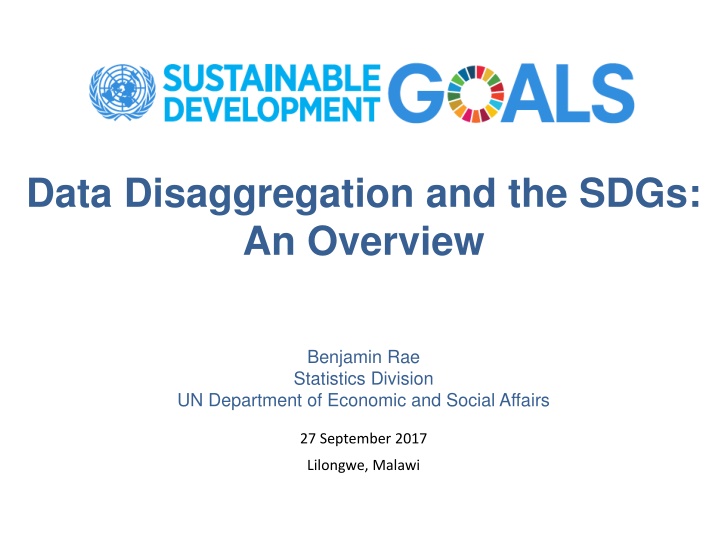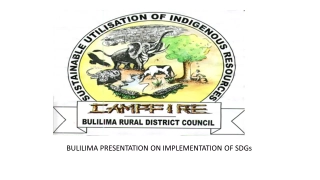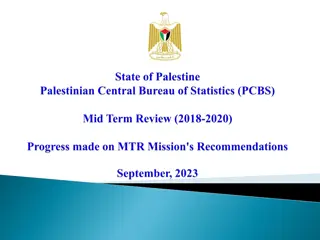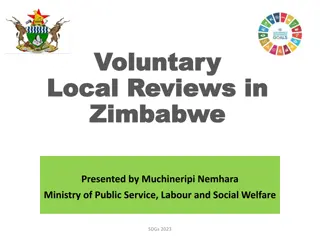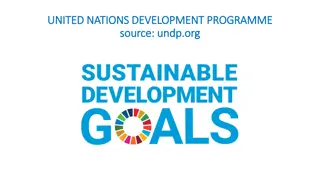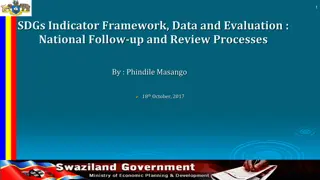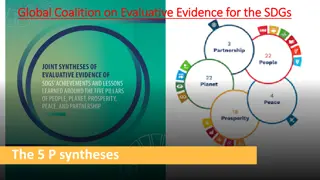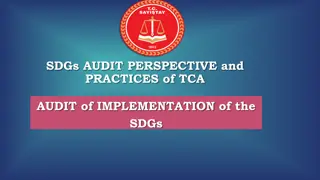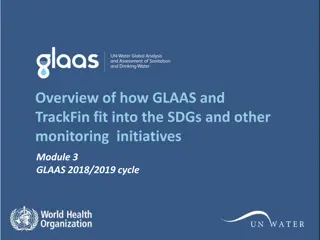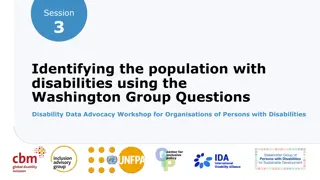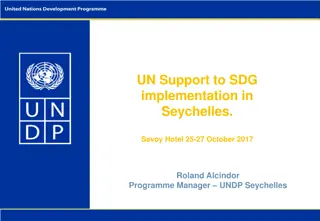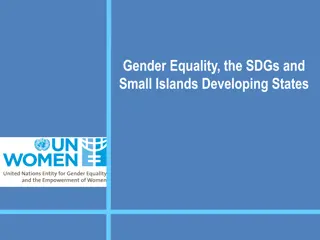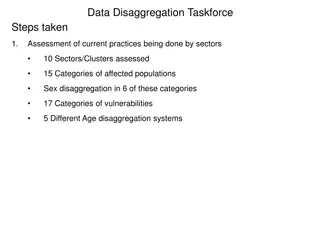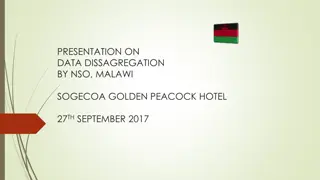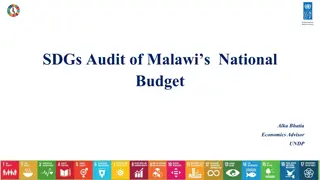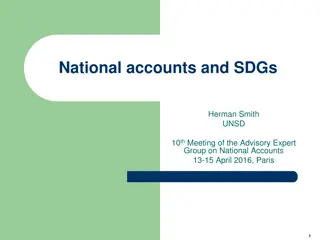Data Disaggregation and the SDGs: An Overview
Data disaggregation is crucial for achieving the Sustainable Development Goals (SDGs) by ensuring that no one is left behind. This overview explores the Global SDG Indicator Framework, the concept of Leaving No-One Behind, and the importance of disaggregating data to identify and address the needs of vulnerable populations. Examples and insights on data disaggregation in the context of Colombia are also discussed.
Download Presentation

Please find below an Image/Link to download the presentation.
The content on the website is provided AS IS for your information and personal use only. It may not be sold, licensed, or shared on other websites without obtaining consent from the author.If you encounter any issues during the download, it is possible that the publisher has removed the file from their server.
You are allowed to download the files provided on this website for personal or commercial use, subject to the condition that they are used lawfully. All files are the property of their respective owners.
The content on the website is provided AS IS for your information and personal use only. It may not be sold, licensed, or shared on other websites without obtaining consent from the author.
E N D
Presentation Transcript
Data Disaggregation and the SDGs: An Overview Benjamin Rae Statistics Division UN Department of Economic and Social Affairs 27 September 2017 Lilongwe, Malawi
Overview 1. The Global SDG Indicator Framework 2. The Concept of Leaving No-One Behind 3. Data disaggregation and the SDGs 4. Work of the IAEG-SDGs on data disaggregation
The Global indicator framework 232 unique indicators, at least one per target a few indicators repeated under different targets Indicators are at different levels of development Tier 1 metadata are fully developed and data are available Tier 2 metadata are developed but data are very sparse Tier 3 methodological work is needed to develop the indicator
The Concept of Leaving no one behind Member States have pledged to leave no one behind IAEG-SDGs has included an overarching principle of data disaggregation: Sustainable Development Goal indicators should be disaggregated, where relevant, by income, sex, age, race, ethnicity, migratory status, disability and geographic location, or other characteristics, in accordance with the Fundamental Principles of Official Statistics (General Assembly resolution 68/261). The IAEG-SDGs also ensured that indicators cover specific population groups and other disaggregation elements specified in the targets.
The Concept of Leaving No one Behind: Importance of data disaggregation Aggregates mask what is happening at the individual level. In order to measure progress detailed information about the most vulnerable needs to be available.
Example: Data disaggregation Share of households per Basic Unmet Needs index, Colombia Zooming into Cundinamarca Department Colombia National Administrative Department of Statistics, 2005
The Concept of Leaving no one behind In order to ensure no one is left behind, we need data sources that: Capture every unit Capture all relevant groups We most also identify the most vulnerable (both people and groups) for better targeting
The Concept of Leaving no one behind Indicators defined with specific groups for disaggregation Indicators with no specific disaggregation defined - yet And from a data source point of view: Indicators with disaggregates as denominators: indicator based on a disaggregate For data sources that collect information on a higher level aggregate (e.g. total population)
The Concept of Leaving no one behind Leaving no one behind, disaggregation, exclusion closely related If we need to leave no one behind in data work, we need to have disaggregated information for every one or every group, the most vulnerable Excluded populations are usually the most vulnerable (hard to reach populations, ethnic groups) exclusion by incomplete coverage
The Concept of Leaving no one behind Additionally, exclusion by design leads to absence of relevant disaggregation: Household surveys will not include institutional populations School based surveys will be confined to children attending school Administrative data may cover only those enjoying services Data sources need to work together to build the story
Opportunities in the SDGs specific groups mentioned in the targets Target 2.3 by 2030 double the agricultural productivity and the incomes of small-scale food producers, particularly women, indigenous peoples, family farmers, pastoralists and fishers, including through secure and equal access to land, other productive resources and inputs, knowledge, financial services, markets, and opportunities for value addition and non-farm employment Issues of disaggregation Target 5.4 by 2030, eliminate gender disparities in education and ensure equal access to all levels of education and vocational training for the vulnerable, including persons with disabilities, indigenous peoples, and children in vulnerable situations Population groups Target 8.8 protect labour rights and promote safe and secure working environments of all workers, including migrant workers, particularly women migrants, and those in precarious employment
Data disaggregation and the SDGs: Challenges More emphasis on disaggregation will lead to challenges in: Cost to collect and analyze Quality Pressure to collect more information stretching the boundaries Sample sizes Confidentiality Politics of data, transparency .. and more
Data disaggregation and the SDGs: Challenges The challenge is not disaggregation alone The call is for high quality, timely, disaggregated data .. for a very broad agenda More targets, more indicators, more frequently, with more disaggregation .. faster, deeper and wider Demand for multi-dimensional disaggregation will increase: Disaggregating within disaggregates child labour in poorest quintile in urban areas for better targeting Many indicators are based on specific population groups further disaggregation will be needed
Methodological work on data disaggregation Methodological work needed for data disaggregation not to be underestimated New and/or difficult disaggregates Need methodological work to develop standards, measurement tools and protocols Need to continue work on some old disaggregates Methodological work still needed Improve quality of data on disaggregates (e.g. age) Set better standards (e.g. residence)
Methodological work on data disaggregation Comparability: Comparability of disaggregates may be more challenging than the indicators If progress will be measured by reduction of inequalities, then comparability will be important, over time and within & across countries We may need to aggregate the disaggregates for example, for national or regional monitoring Some disaggregates are more comparable than others (sex, age) while some are problematic although they do not seem to be (urban) others are new
Data disaggregation and the SDGs Concerns with disaggregation How to ensure that the disaggregation is not pushed to the national level only--need to reflect this at the global level. How do we include consistent listing of marginalized groups and disaggregation Do we have to? What role does national context play? Feasibility of producing disaggregated data all levels Cost implications
IAEG-SDGs work on data disaggregation Decisions of the Statistical Commission: The 47th Statistical Commission decision 47/101 (n) requested the IAEG develop the necessary statistical standards and tools, including by establishing a working group to work on data disaggregation as a subgroup of the Inter-Agency and Expert Group. The 48th Statistical Commission decision 48/101 (j) welcomed the work stream on data disaggregation to ensure that the indicators respond to the ambition of the 2030 Agenda for Sustainable Development that no one will be left behind
IAEG-SDGs work on data disaggregation Definition of Disaggregation: Disaggregation is the breakdown of observations within a common branch of a hierarchy to a more detailed level to that at which detailed observations are taken. With standard hierarchical classifications [ ] categories can be split (disaggregated) when finer details are required and made possible by the codes given to the primary observations. Disaggregation dimensions the characteristics by which data is to be disaggregated (by sex, age, disability, etc.) Disaggregation categories the different characteristics under a certain disaggregation dimension (female/male, etc.)
IAEG-SDGs data disaggregation work plan (1) Proposal: Initial Starting Point for the disaggregation of each indicator The initial starting point for disaggregation consists of the dimensions stated in the accompanying target as well as the dimensions stated in the indicator name itself The work at this initial starting point for disaggregation will take place in three workflows: Workflow A: Data availability for initial starting point disaggregation Workflow B: Harmonization Workflow C: Tools and Methods
IAEG-SDGs data disaggregation work plan (2) Workflow A: Data availability for initial starting point for disaggregation 1. Analyze data availability for the dimensions for the initial starting point for disaggregation. Should start with Tier I indicators since data should already be widely available. At national level, Tier II indicators with data availability could also be used. 2. Develop an indicator classification system based on data disaggregation availability. Each dimension for every indicator would be classified into one of three groups based on data availability 3. After Workflow B is completed, the classification system for data availability would be complemented by an additional * category, reflecting data availability along the harmonized categories
IAEG-SDGs data disaggregation work plan (3) Workflow B: Harmonization The work in this workflow consists of: 1. Clarify the definition of the dimensions identified at the initial starting point for disaggregation 2. Consult experts from different statistical domains and working groups in order to identify categories used for different dimensions 3. Define harmonized categories for future capacity building. These should take international standards into account, as well as accounting for diversity. Some dimensions may have a fixed number of categories, while others may have an open range of categories. The categories may also vary according to the subject
Thank You! Questions?
